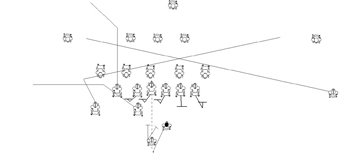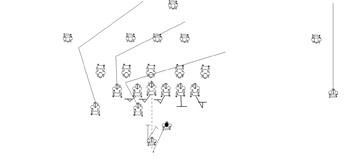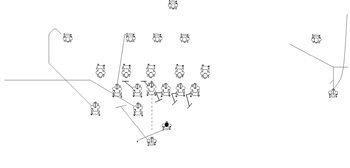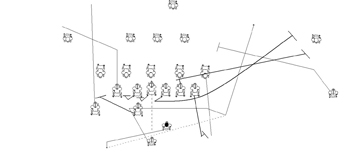The “A” Formation: Simplified & Updated
March 2nd, 2010
Q&A Part Two: The Passing Game
Direct Snap: Let’s move on to the passing game. Apart from the QB Boot, which is a run-pass option, what does the aerial attack look like in your revised “A” formation offense?
Ted Seay: As with everything else in football, I try to keep things as simple as possible, but without sacrificing capability. I don’t want things so simple that the defense can easily figure out how to shut us down. That tells me that I need to teach a small number of pass route packages, and a couple of pass protection schemes, but also that I have to choose the most versatile plays and blocking schemes possible. A great example is the Under pass route package.

Before I start with the receivers and their assignments, though, let me talk about the important players – the offensive line. They are using a pass protection scheme called Half-Slide for both the Under and Over pass packages, which starts with the Strong side of the line and “slides” to the Quick side. The linemen starting with the Outside Tackle will block a defender over them man-to-man. This continues down the line until the first “bubble” is encountered. Starting with, say, the Strong Guard (if he has a linebacker over him), the rest of the line will block the gap to the Quick side of the formation. This scheme allows six blockers to pick up most defensive looks with no problem.
It does ask the Tailback to do one difficult thing, however – he must double read the strong outside linebacker and the next linebacker inside him. If neither linebacker blitzes, the Tailback can help out one of the linemen with pass blocking; if one blitzes, the Tailback will block him; but if they both blitz, the Tailback will block the one who is closest to the QB (almost always the middle LB) and yell out “Fire! Fire!” to alert the QB that there is an unblocked defender heading his way.
Back to the receivers — Under is a simple package to teach, but a very difficult one to defend. The first thing it does is make good use of the built-in Bunch (Wingback, Tight End and Blocking Back aligned close together); the second thing it does is cross receivers, making it difficult to play straight man coverage; and the third thing is to flood the edge of the field with receivers, making it difficult to play zone defense, too. The QB can read this a number of ways, but the easiest is to look for the Blocking Back in the flat, followed by the Tight End’s Corner route, and finally the Split End’s Shallow Cross which will open up slightly later. You can also decide from the sideline to throw to the Wingback on the backside of the play once the defense starts ignoring him – which it will.
Finally, you can tag different receivers with routes that change the dynamic of the play. For example, “Under - TE Post” tells everyone else to run their Under routes, but the TE will run a Post rather than a Corner. If you’re seeing a lot of man coverage, this allows the QB an even easier set of reads: He looks at the Post first, then drops down to the mesh of receivers that occurs when the Split End crosses underneath the Wingback – whoever comes clean out of the mesh will get the ball.
DS: That sounds like a very useful pass play.
TS: It is, and there are three others that allow you to attack a range of defensive systems and coverages. The next one is the Over route package, which attacks the side of the field away from the Bunch – this can be very useful when defenses start to “overplay” the Bunch side in passing situations.

DS: So this would also be effective against man and zone coverage?
TS: Absolutely, especially if you do as I recommend and put your best receiver at Split End. The passing game is designed to achieve one-on-one situations for your best receiver, and you need to be able to take advantage of those when they occur. If the defense starts cheating its safeties over toward the Bunch as a result of the Under pass, the Over package can score faster than any other play in football – one slip by a defender, and the Split End is gone.
DS: How else can you make use of a talented receiver at Split End in this offense?
TS: There are several ways, even in as small a package of plays as this. You’ll notice as you look through the different plays that the Split End only does a few things when he release off the line of scrimmage, but these few actions are deceptive – he may be running a Slant route, for example, or he may be crack-blocking on a defender. The best thing you can do for a great receiver at Split End, however, is teach him Run & Shoot-style Choice routes, which feature in the next two pass packages.

The Stick package is a staple at every level of football from high school to the NFL – if you aren’t running it, you should be. On the Strong side of the formation, the Bunched receivers run the Stick package itself, while on the backside the Split End reads the leverage of the nearest defender and decides before the snap what route he is running from a choice of four: Hitch, Quick Out, Slant, and Fade.
Before I get into the receivers and their actions, however, let me talk for a minute about the QB and the line. Unlike the Under and Over packages, the QB is not dropping straight back, he is half-rolling to a spot behind where the Quick Guard originally lined up. And unlike their Half-Slide protection in the Over and Under packages, the line will use Sprint pass pro for the next two passes. Sprint pro is very basic – the playside will Reach block the first defender to their outside, and the backside will Hinge block – protecting their playside gap first, but then drop-stepping and forming a wall to the backside of the play that pass rushers must go around in order to get to the QB. The Tailback, meanwhile, blocks the first defender outside of the Quick Guard’s Reach block.
Back to the pass package — first, the Stick routes by the Bunched receivers. The Wingback runs what I call a Hard Fade route, which is a Slant Out route run at a 45 degree angle to the LOS. This places outside defenders in an immediate bind, since they are not generally used to gaining both depth and width at full speed. The Wingback is only a target of opportunity in this package, however – you will generally only throw to him if his defender slips and falls. The Tight End and Blocking Back can now concentrate on the first shallow defender inside the cornerback – with the Wingback opening up space to the outside, the TE and BB can effectively “double-team” that shallow defender, whether he is an outside linebacker or a strong safety. The QB’s eyes will go immediately to the Blocking Back’s Flat route – if he is open, throw him the ball. If the “read” defender widens with the Blocking Back, however, the QB will come right back inside to the TE and hit him on his outside number. This allows the TE to immediately spin his shoulders downfield and make maximum yards before he is tackled.
On the backside of the play, meanwhile, the Split End is looking to see how the cornerback is playing him – if he’s aligning in a press position, the SE will run a Fade route; if he’s playing a softer technique (more than 5 yards off the ball) with inside leverage, the SE will run a Quick Out; with outside leverage, the SE will run a Slant; and if the corner is deeper than 8 yards off the ball before the snap, the SE will run a Hitch. The same rules apply to the Split End in the final pass package, the Space pass.

On the Bunch side, the Stick package (which you should run first) will open things up very nicely for the Space package. The Wingback takes an identical Hard Fade release for the first few steps, but then stems vertically and finally curls in toward the QB – this is a “Mini-Curl” route that leaves him about 7 yards deep. The Tight End, meanwhile, will replace the nearest inside linebacker with a “Sit” route – when he gets to a depth of about 5 yards, he will turn and show his numbers to the QB. The Blocking Back runs the same Flat route he does in the Stick package, but now he is the only “moving part” on the strong side of the formation. Both the WB and TE are stationary targets who are easy to spot and throw to, making this package a very easy one to teach to QBs. The reads are also simple – at higher levels, I give the QB a straight progression across the field from SE to TE to WB to BB; at lower levels, however, I tell the QB to look first to the WB’s Mini-Curl route and throw it whenever he is open. If the Mini-Curl throwing lane is “invaded” from the outside, the QB looks right away for the BB’s Flat route; while if a defender “invades” the Mini-Curl lane from the inside, the QB’s eyes go immediately to the TE’s Sit.
Again, as with the Stick package, if the QB likes what he sees with the SE and his Choice routes – if you think you have a good match-up there any time either Stick or Space is called, in fact – he can choose to take the snap and throw to the SE whenever he wants, and he will always be “right” in his decision. We may coach him up on execution if the play doesn’t succeed, but he can never be wrong if there is single coverage on the SE and the QB goes to him on these two plays.
DS: How about the screen pass you mentioned?
TS: The Flow Screen is a concept I got from Andrew Coverdale (as are Under, Over and Space, for that matter). It works best as a counter to the half-sprint action used in the Stick and Space passes, so I will normally only use it after I’ve established those one or both of those two plays.

The Tailback sets up to block on the frontside of the Sprint pass pro scheme, but you will notice his block isn’t actually needed – the Blocking Back is also staying in to block. After one second the Tailback will drift toward the backside, setting up at a spot four yards outside the Outside Tackle’s original position and four yards behind the LOS. The QB will half-sprint, stop, and throw back to the Tailback, who will have 3-4 blockers ahead of him when the play is executed properly. If the defense is “selling out” to the Bunch side when they see half-sprint action from the QB, the Flow Screen can really sting them for big yards.
DS: Any last thoughts on the revised “A”?
TS: Just this – I recommend the “A” as a change of pace for coaches who are already running direct snap offenses, but I also think it can be a very useful “Pistol substitute” for other coaches who are looking to add something different to their offense. The “A” offense is small and easy to teach, and it gives you a lot of capabilities for a relatively small investment in practice time.Another advantage is that, for under-center teams, it allows you to play a good ball-handling/good passing QB in a similar position, rather than forcing him to be a dual threat runner/passer in the single wing. If that’s a skill-set that you currently have, the “A” will be an easy adjustment for you, but a totally different look for defenses.